- Home
- About
- Courses
- IR/INFO CONFERENCE
- Software
- EXPERT SERVICES
- STANDARDS
- Proposal Templates
- Electrical Systems and Rotating Equipment
- Building Envelopes
- Insulated Roofs
- Photovoltaic Systems
- Pest Detection
- Yachts and Small Craft
- Thermal Imaging of Horses
- Optical Gas Imaging
- Measuring Reflected Temperature
- Measuring Emittance
- Measuring Transmittance
- Distance/Target Size Ratios
- Complete Series
- Resources
- BUSINESS OPPORTUNITIES
- STORE
List of articles contained in the IR/INFO 2016 Proceedings:
Allinson, John (Jack) N., BSc, AMS®
Level III Certified Infrared Thermographer

J.N. Allinson Associates, Inc.
222-2 University Blvd. North Jacksonville, FL 32211
904-721-2177
www.allinson.com
This email address is being protected from spambots. You need JavaScript enabled to view it.
IR Thermography and Related NDT Technologies for Detection of Damage to Boats Constructed with FRP and Composite Materials
Abstract:
More often than not, boats constructed with fiberglass reinforced plastic (FRP) and composite materials are damaged by lightning strikes, collision, and allision (moving boat striking a stationary object). In the insurance world of indemnifying the insured of a recreational yacht and/or small craft against loss, the extent of damage is often key in determining whether the boat can be economically repaired to pre-loss condition within the confines of policy coverage.
Defendable opinions of the cause, nature, and extent of damage are key items that an insurance claims adjuster needs to make decisions. More often than not a qualified Marine Surveyor can use non-destructive testing (NDT) as a means to provide those opinions to the insurance claims adjuster.
This presentation will provide pictorial examples of the types and extents of damages found by following the 2011 edition of the Infraspection Institute “Standard for Infrared Inspection of Recreational Yachts & Small Craft Constructed of Fiberglass Reinforced Plastic and Composite Materials”.
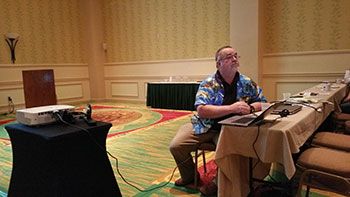

Beauchemin, Oliver F.
Owner, Accolade Group of Vermont, LLC

PO Box 10
Waterville, VT 05492
802-644-8362
This email address is being protected from spambots. You need JavaScript enabled to view it.
The Disruptive Power of 10x
Abstract:
Being disruptive is the new normal. Even if being disruptive will kill your existing business. Kill it dead.
Google has been doing just this. Google has been killing its business model over and over, each time creating a new model.
But now Google has hit upon the next plus ultra of disruption. If you aren’t up to speed on what Google is doing to disrupt your business…you may soon find yourself out of business.

Bethel, Noah
CMRP
Vice President of Product Development

PdMA Corporation
5909-C Hampton Oaks Parkway Tampa, FL 33610
813-621-6463
www.pdma.com
This email address is being protected from spambots. You need JavaScript enabled to view it.
Gaps … In Your Electric Motor Reliability Program
Abstract:
The best laid plans … is an idiom that should not come to mind if you’re describing your electric motor reliability program; however, many have seen a great plan, or at least what was thought to be a great plan, fail to meet expectations.
This paper will discuss the common gaps in the implementation and operation of an electric motor reliability program including mistakes in quality control, trending, and troubleshooting of electric motors.
Also included will be how to apply electrical fault zone analysis principles toward identifying root cause failure analysis, review detailed analysis techniques in quality control to extend motor life expectancy, learn proper application of root cause failure analysis when troubleshooting electric motors, and how to identify and overcome the data analysis versus data collection imbalance.


Brady, James
Level III Certified Infrared Thermographer

Brady Infrared Inspections, Inc.
935 Pine Castle Court
Stuart, FL 34996
772-288-9884
www.bradyinfrared.com
This email address is being protected from spambots. You need JavaScript enabled to view it.
Infrared Inspection of Industrial Steam Generating Boiler and Associated Air Pollution Control System
Abstract:
This presentation deals with the use of infrared thermography to inspect an industrial steam generating boiler and associated air pollution control system.
This particular system burns municipal waste to generate electricity that is fed into the local power grid system.
The boiler complex is 11 stories high and consists of 3 separate units all contributing steam to a single turbine unit.
Flue gases are run through a complex air treatment system prior to exhausting to the atmosphere.
This inspection served as quality assurance associated with in-progress construction of the system.
Items that will be discussed include insulation deficiencies, construction practices that affect process efficiency and safety issues.
Also discussed are challenges associated with low emittance targets such as insulating panels and pipe wrappings.


Bruni, Bart
Level II Certified Infrared Thermographer
State Certified Termite and Pest Operator

Bruni Infrared, Inc.
326 Northlake Drive
North Palm Beach, FL 33408
954-454-5357
Certified Termite Thermography a Must for Property Owners
Abstract:
This paper will discuss inside information regarding why certified termite thermography is an emerging market and a sure winner for Pest Thermographers.
The key to a successful subterranean termite treatment is finding live infestations.
For decades, termite management professionals have relied upon limited visual and often destructive inspections to locate infestations, and they still do.
Building materials, methods, and architectural trends are always changing, thus making subterranean termites increasingly difficult to find.
Generally termite companies do not use infrared, but why?
This paper will expose shocking undisputable facts that the National Termite Industry does not want you to know.


Campbell, William
Level II Certified Infrared Thermographer

Campbell Thermography, LLC
1059 Shady Oaks Drive
Ann Arbor, MI 48103
734-662-7179
This email address is being protected from spambots. You need JavaScript enabled to view it.
Can You “See the Forest for the Trees?” Optimizing Image Perspective for Qualitative IR Inspections of Roof and Steam Distribution Systems
Abstract:
Qualitative IR inspections document thermal patterns across the surface of objects.
As the target size increases, the viewable area must increase to capture enough information in order to recognize useful thermal patterns.
This presentation will explore the pros and cons of increasing target distance, camera lens FOV, and stitching images to increase the viewable area when inspecting roofs and steam distribution systems.
Examples shown will include a 190° manhole cover from 4 to 3500 feet and a handheld camera hoisted 30 feet above a building roof to improve image perspective.


Chandler, Carol
Doctor of Oriental Medicine
President

Med-Hot Thermal Imaging, Inc.
5120 South Florida Avenue,
Suite 301 Lakeland, FL 33813
863-646-1599
www.med-hot.com
This email address is being protected from spambots. You need JavaScript enabled to view it.
The Use of Thermography in Elevated Body Temperature Screening
Abstract:
When properly implemented, thermography is the most efficient non-contact, cost effective and reasonably accurate solution for mass screening of individuals for elevated body temperature (EBT).
It was first introduced in 2002 with the highly infectious disease called SARS (Severe, Acute Respiratory Syndrome) epidemic, which originated in the Guangdong Province of China and eventually spread to 29 countries.
Screening to detect a potentially infected person played an important role in preventing the spread of SARS.
A great deal has been learned since the initial experience of 2002 when there were no guidelines for effective screening.
Even today we see videos of live screening activities with inappropriate equipment and little or no human or environmental protocols, sometimes resulting in ineffective and disappointing outcomes.
Thermography has great potential, but unless it is used properly it will become a prop for perceived action in a panic situation.
This paper will discuss the benefits and limitations of infrared thermography when used to remotely screen for elevated body temperature, appropriate target areas of the body for screening, and the placement of thermal imagers for optimal data collection.

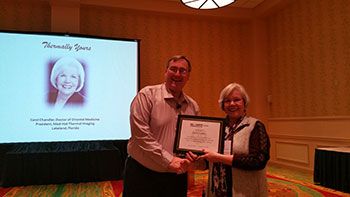
Clark, Alan
T/IRT Level II Thermographer

Palmer Wahl Instrumentation Group
234 Old Weaverville Road
Asheville, NC 28804
828-658-3131
What are We Really Measuring? Setting up your Imager to Take Accurate Temperature Readings
Abstract:
One subject that needs to be repeated to thermographers is what are they actually seeing when they look at their display.
We speak of FOV, IFOV, and IFOVmeas. What do these terms really mean?
What is the temperature point cursor actually measuring?
Why do we select auto range spans versus manual range spans?
What are the important selections in setting up the imager to record data?
What can I fix and what can I not fix in the software, later, if I get some setting wrong?
Why so many palettes and is one better than another?
What do point cursors, profile lines, area boxes, etc. do for me?
Can any of those points be set up to read different surfaces compared to other surfaces?
Are alarms and isotherms useful in telling me something of value?
This presentation will cover multiple issues to keep in mind when setting up an imager for a job.


Getsug, Marie
Senior Consultant
M&R Services

Commissioning Agents, Inc.
Clarksville, MD 21029
www.cagents.com
This email address is being protected from spambots. You need JavaScript enabled to view it.
Help OEMs Help You: Getting Better Designs for Predictive Technology Application, Automation, and Reliability from Your Suppliers
Abstract:
With the introduction of the ISO 55000 Asset Management standards focusing on life-cycle cost and risk-based performance, what impact does an Original Equipment Manufacturer (OEM) have on the ultimate design, reliability, and success of a project? How can engaging the OEM as a partner and stakeholder impact the following statistics?
1. As much as 60% of failures & safety issues can be prevented by making changes in design
2. 80% or more of a facility’s life cycle cost is fixed during the plan, design, and build phases
3. 30-40% of equipment breakdowns are related to poor equipment design or condition
With these odds, how can a firm ensure they come out on the right side of their asset investment decisions? Part of the answer can be found in the very beginning of the project. This presentation introduces processes to apply during the conceptual and preliminary design phases of capital projects to identify the best OEM partners and how to hold them to a higher standard for optimizing the design, maintainability, reliability, and performance of the assets they build. The following key items are discussed:
1. Request for Information (RFI): Identify the best-positioned OEMs to leverage reliability and automation as a partner and stakeholder
2. Request for Proposal (RFP), User Requirement Specifications (URS), Engineering Specifications: Integrate detailed maintenance & reliability standards and specifications into the design from the beginning
3. Design for Reliability (DfR): Identify and design out repeat failures on similar equipment, Design for maintainability, operability, reliability, accessibility, clean-ability, & rig-ability etc.
4. Process Analytical Technology (PAT): Leverage automation by identifying and trending pending quality and reliability failures with instrumentation triggers
5. OEM Performance Criteria: Establish detailed performance criteria
6. Documentation Requirements: Specify required documentation, training, and development of optimized maintenance and spare parts strategies


Hixson, Ben T.
Hixson Consultants, Inc.

947 First Avenue West
Alabaster, AL 35007
205-663-2220
205-664-5115
This email address is being protected from spambots. You need JavaScript enabled to view it.
Mineral Wool Cover Board Makes Sense for Accurate Infrared Scans
Abstract:
The Army Corps of Engineers, ASHRAE 90-2013, roofing membrane manufacturers, and green construction practices are requiring roofing infrared moisture scans for new roofing installations in an effort to better ensure thermal resistance performance.
This is a significant movement toward accountability of the roofing system installer to ensure they have not used wet materials and have not permitted damaging water entry at overnight tie-offs and other work stoppage.
Snow blinding white Energy Star compliant single ply roofing membranes such as TPO, PVC, CPA, and Elvaloy KEE modified PVC membranes are very reflective and combined with gypsum roofing cover boards can make IR scanning brand new installations challenging.
Gypsum cover boards and popular isocyanurate and extruded polystyrene insulations are popular but are not appreciatively porous enough to absorb moisture readily detectable via non-destructive infrared moisture scans.
High density mineral wool or Roxul high density insulation cover boards are somewhat porous and can serve the Owner and other project entities involved in the project well.
Moisture trapped in the boards may be detected by an experienced and knowledgeable infrared thermographer.


Isleifsson, Bjarni Ellert
CMRP, CRL

+1 416-687-8453
+1 647-628-9704
This email address is being protected from spambots. You need JavaScript enabled to view it.
The Big Picture of Thermal Imaging from an Organizational Perspective
Abstract:
This presentation will focus on the larger picture of Thermal Imaging, how companies select their Key Performance Indicators (KPIs), and how Thermal Imaging can support the overall organizational objectives in a impactful way.
Bjarni is a Certified Maintenance and Reliability Professional and Certified Reliability Leader with over 25 years of experience in Asset Management, Maintenance and Reliability, Condition Monitoring, Operations, and Project Management in various industry roles and consulting.
Well versed in various maintenance methodologies including TPM, RCM, BCM, VDM as well as LEAN principles, Bjarni participated in the Standards Council of Canada Mirror Committee, TC 251 Asset Management, and in the development of ISO 5500x Asset Management series of standards.
A founding partner of the Icelandic Maintenance Association, Bjarni currently sits on the board of Directors for Plant Engineering & Maintenance Association of Canada (PEMAC) and participates in the Global Forum on Maintenance & Asset Management (GFMAM) and the World Partners in Asset Management (WPiAM) on a variety of topics related to Asset Management.
A seasoned lecturer on matters related to Asset Management Strategy, Maintenance Management, Condition Based Maintenance, and Reliability Engineering, Bjarni has spoken at several conferences worldwide, such as the IMC Conference and Euromaintenance.


James, Sonny
Level III Certified Infrared Thermographer
Owner, Senior Instructor / Managing Director

NDE Institute of Trinidad, Ltd. / Thermal Diagnostics Ltd.
15 Robertson Street, Les Efforts East San Fernando, Trinidad & Tobago, West Indies
868-653-9343
868-657-6572
www.learnndt.com
www.tdlir.com
This email address is being protected from spambots. You need JavaScript enabled to view it.
Diversification of Your Infrared Business – A Peek Into the Petrochemical & Chemical World
Abstract:
Thermography and related infrared applications have been used for decades in the petrochemical and chemical industries; however, it has been quite a mystery to many on how to penetrate such an industry. The three most asked questions by thermographers are:
- How does one penetrate this industry?
- What can be inspected in a refinery?
- How much money can one actually make in this industry?
I have been successfully involved in this industry for over twenty years as a contractor and consultant and one thing I know for sure is that this industry is very dynamic and never static.
This is one of the major reasons that many thermographers find it very difficult or confusing to get into successfully.
The rules are always changing and many aspects also move with the current and projected price of crude oil.
However, even though it sounds like a daunting task, following a strategic path may increase your chances for a long lasting constant stream of business within this industry.
This paper will address in global terms the above three most asked questions about doing business in the petrochemical and chemical industry.
The information will be applicable for doing business in all plants around the world.
It will give you a peek into a world that is beyond residential and commercial thermography and you can then decide if the grass is really greener on the other side.


Kiez, Randy
Level III Thermographer

ATLAS Infrared Inc. / Exp Services Inc.
5500 Falsbridge Drive NE
Calgary, Alberta T3J 5J0 Canada
403-554-6749
This email address is being protected from spambots. You need JavaScript enabled to view it.
This email address is being protected from spambots. You need JavaScript enabled to view it.
Checking for Flaws in Spray Foam Insulation Using Infrared and Blower Door
Abstract:
Spray applied foam is accepted in the construction community as having superior thermal insulation properties, air barrier qualities, and vapor diffusion control (depending on the type).
The product is often specified to serve overlapping duties as a thermal insulator to resist conductive heat flow, as part of the air barrier system to control convective heat transfer, and as a vapor retarder.
These characteristics make it a desirable product for use in ‘high performance’ buildings, in retrofit applications where the original materials have failed, and in tight applications where achieving good thermal and air/vapor control using ‘traditional’ methods is difficult.
The perceived monolithic nature of spray foam reinforces its reputation as having infallible air control; however, this is not necessarily the case.
Errors in its application and movement of the substrate against which it is applied can compromise its performance.
Flaws within the assembly that allow (warm) moist air to meet dew point cause condensation which can lead to deterioration and biological growth.
Pinpointing gaps in application can be accomplished using the effective combination of a blower door to induce air flow and an infrared camera to capture the resultant thermal patterns due to air movement. Isolating the air leakage and presenting visible proof can really emphasize to clients and foam applicators alike the need for quality application.
This presentation will show infrared images and photos of flaws in spray applied foam that caused problems or could have caused problems had they not been preemptively addressed.


Kochanek, Ed
Eastern Region Sales Director

FLIR Systems, Inc.
22 Overlook Drive Woolwich, NJ 08085
866-379-4022
www.flir.com
This email address is being protected from spambots. You need JavaScript enabled to view it.
Congratulations on your Infrared Camera Purchase – Now What?
Abstract:
You’ve spent all your time trying to figure out which camera is best for you.
You’ve considered all the features including number of pixels, sensitivity, and connectivity to mobile devices.
You’ve made your decision, bought, and received the camera.
Is that the end of the decisions you will have to make?
Of course not.
There are many choices that you should consider as soon you get your camera because ignoring them can cost you in the long run.
This paper will discuss what you should do next and how to plan for the future with your latest investment.


Messer, Adrian
Manager of US Operations

UE Systems, Inc.
864-224-4517
914-282-3504
www.uesystems.com
This email address is being protected from spambots. You need JavaScript enabled to view it.
NFPA 70B … Where Does Ultrasound Fit?
Abstract:
When it comes to establishing an electrical maintenance program for your facility, there are many resources at your disposal to which you may refer. As for the tools that can be used to inspect energized electrical equipment, an infrared camera is probably the first tool that comes to mind. Perhaps you thought of an airborne ultrasound instrument.
If you thought ultrasound, you are among a growing number of maintenance and reliability professionals who have come to realize that airborne ultrasound is a viable tool that can be effectively used to inspect and diagnose conditions such as corona, tracking, arcing, and partial discharge in energized electrical equipment.
The standards that have been written to assist in implementing or improving an electrical maintenance program are the United States’ National Fire Protection Agency (NFPA) 70B, and the Canadian equivalent, Canadian Standards Association (CSA) Z463.
This paper and presentation will discuss the differences between the two standards when it comes to the utilization of ultrasound as an inspection tool for electrical maintenance. Information will also be presented on how to use ultrasound for electrical inspection of energized electrical assets, and how to improve safety practices associated with electrical assets by reducing the risk of an arc flash incident, because an ultrasound inspection can be done without the opening of the energized electrical asset.
Sound file examples of corona, tracking, and arcing will be presented to give the attendees an example of what would be heard via a headset while performing an ultrasonic inspection of electrical equipment.


Moore, Stephen S.
Level III Thermographer

Moore Infrared, LLC
PO Box 277 Saline, MI 48176
734-476-8104
www.mooreinfrared.com
This email address is being protected from spambots. You need JavaScript enabled to view it.
Using Infrared to Find Grocer Refrigerated Food Temperatures: An Analytical Approach
Abstract:
Ever wonder how cold the perishable foods on temperature-controlled refrigerated shelves in your favorite grocery store might be? Maybe it’s a bit too “warm”?
The author started investigating this very subject back in 1999 with his new Agema 570. With the willingness of his favorite local grocery store chain, it all became possible.
This presentation is about precision temperature evaluation and the many nuances affecting the temperature of refrigerated food.
Nunez, Arturo Martinez, Caricia
Mistras Group, Inc.

195 Clarksville Road Princeton Junction, NJ 08550
609-716-4000
This email address is being protected from spambots. You need JavaScript enabled to view it.
This email address is being protected from spambots. You need JavaScript enabled to view it.
Early Detection of Defects Using Acoustic Emission and Vibration in Power Transformers
Abstract:
Vibration analysis in power transformers can provide important and useful information in the evaluation of the mechanical integrity of these assets, without the need to remove the transformer from service to perform the inspection.
However, unlike in rotating machinery, analysis of vibration profiles can be a difficult task, since there are no specific test procedures, diagnostic models, or standards that help evaluate the mechanical condition of the transformer based on the vibration profiles.
In addition, vibration in power transformers is produced by a complex combination of different physical and operating variables, such as transformer design and manufacturing process, voltage, load current, and temperature levels of the transformer, etc.
In recent years, several projects have been performed in order to develop diagnostic models and techniques that can be used as an alternative for online monitoring of power transformers.
One basic test procedure is to perform a vibration screening, taking measurements in different areas of the transformer, in order to identify areas with higher vibration levels.
A periodic screening program can be used to determine any deviations in the vibration levels, which can be an indication of an ongoing mechanical defect.
The disadvantage of this technique is that the operating conditions of the transformers should be considered when comparing new measurements with previous results, in order to avoid misinterpretations.
Another option is to implement an on-line monitoring system capable of continuously measuring the vibration levels, as well as the operational parameters (e.g. load current, voltage, oil temperature, etc.).
This method provides an easier way to understand the behavior of the vibration based on the operating conditions of the transformers.
Also, with continuous monitoring it is possible to detect, in early stages, variations in the vibration profile that can indicate the development of a mechanical problem, like winding/core looseness or deformation.
The monitoring of vibration in transformers, along with other techniques (e.g. DGA, AR, IR, etc.), provides useful information that can be used to detect the development of faults in their early stages.
This allows the user to schedule the necessary tasks and/or inspections to confirm the fault, and repair or replace the unit.
This paper presents several case studies where vibration allowed the early detection of incipient faults in power transformers.


Robinson, Martin
CEO, Level-III Thermographer
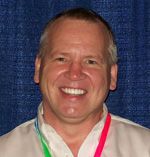
IRISS Group
10306 Technology Terrace Bradenton, FL 34211
941-907-9128
www.iriss.com
This email address is being protected from spambots. You need JavaScript enabled to view it.
Reducing Arc Flash Risks with Electrical Maintenance Safety Devices (EMSD’s)
Abstract:
Electrical accidents happen daily; however, there are important steps that companies and individuals can take to reduce the occurrence of these accidents and protect everyone concerned from the physical, financial, and statutory consequences related to this type of accident.
An essential element for electrical safety is before any work is commenced on any electrical equipment, you must ensure that the equipment is in an electrically safe condition.
This presentation discusses how the implementation of closed loop EMSD and online monitoring solutions for electrical distribution systems allows for compliance with NFPA, CSA and OSHA by means of keeping maintenance staff away from energized electrical components by maintaining an enclosed and guarded condition during critical inspections of energized electrical equipment.
Roher, Tim
Client Support & President

Exiscan, LLC
1645 Lyell Avenue Rochester, NY 14606
585-366-0333
www.Exiscan.com
This email address is being protected from spambots. You need JavaScript enabled to view it.
Infrared Windows: Considerations for Installations and Use
Abstract:
Infrared (IR) windows (and other “closed-panel” inspection windows and ports) are quickly becoming an industry-standard method for performing diagnostics on energized electrical equipment.
This presentation will introduce attendees to variables to consider when selecting, installing, and using IR windows:
- Field of View: Size and placement of IR windows relative to targets and obstructions
- Hidden Targets: Considerations for compartmentalized components or components that are located behind IR-opaque touch guards
- IR Window Transmission Rates: When will it matter and how can we compensate for it?
- Alphabet Soup: Making sense of the standards, tests, and claims – insights from someone who actually sits on many of the standards committees
- Why & Where: What factors make use of IR windows advantageous or necessary
This presentation is for anyone involved with electrical preventive maintenance or electrical condition monitoring programs, and those who are involved with electrical safety programs.


Stockton, Greg
President
Stockton Infrared Thermographic Services, Inc.
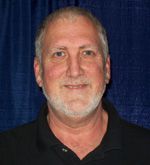
8472 Adams Farm Road Randleman, NC 27317
336-689-3658
www.StocktonInfrared.com
This email address is being protected from spambots. You need JavaScript enabled to view it.
Finding Defects in Concrete Block Wall Construction Using Thermal Infrared Imaging
Abstract:
One might think that the only way to know whether the grouted cells, bond beams, insulation or other components of a CMU (Concrete Masonry Unit) wall are present would be to open the wall with a hammer or a hammer drill to see if they are there.
However, thermal imaging is a far better option and destructive testing is really inadequate, because the sample areas are much too small to know where CMU wall components are missing or misplaced or misaligned.
The only other option is to X-ray the walls or tear them down, which are both extremely expensive.
The thermal infrared method is accurate, non-destructive, and inexpensive.
Infrared testing can be performed at any time during the construction process without interrupting any other trades or affecting the progress of the rest of the building and the result is a documented record of the grouted cells and other structural components (in-situ).
When and if deficiencies are found, reports can be generated so that corrections can be made with surgical precision.
The owner gets what he paid for and the designers can literally ‘see’ that their specifications have been followed.

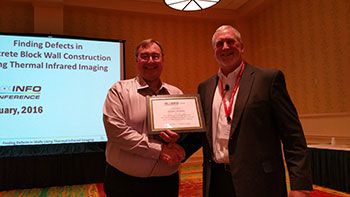
Swirnow, Wayne
President
Level III Certified Infrared Thermographer

Infrared Imaging Services, LLC
PO Box 221 New City, NY 10956
845-641-5482
Building a Sales Plan for a Small Business
Abstract:
You wanted to start an infrared business, received your infrared certification training, purchased the latest and imager and built a great website. So why aren’t prospects calling you?
Individuals with a skill set they desire to monetize often start businesses. When a person with a marketable skill set or product starts a business, it doesn’t imply they also have the talent set to manage that business. Failures in small businesses are ultimately due to lack of sales of the product or service, often by way of the owner’s difficulty in managing the many processes required to make sales.
Sales are the “lifeblood” of a company. Running a business as the “Sole Proprietor” means managing office and procedural requirements such as accounting, responding to contracts, RFP’s, insurance, banking and selling the service. All these mandatory duties must be performed to keep the business running; however, the small business owner is often the only person in the “company” who can generate revenue by producing the product or conducting the salable service.
Often, small business owners find it “hard to see the forest through the trees” while keeping so many balls in the air. The problem is that many small business owners do not have a sales plan.
This paper will discuss the sales plan, and why it must be the number one priority of any business large or small.


Westerberg, Nick
CEO, Westerberg & Associates Corp.

PO Box 567
Liberty Lake, WA 99019
509-951-4399
www.westerbergandassociates.com
This email address is being protected from spambots. You need JavaScript enabled to view it.
Steam System Water Hammer
Abstract:
Condensation Induced Water Hammer (CIWH), is one of the most dangerous conditions found in today’s modern boiler rooms.
Using real case histories, this presentation will focus on steam system water hammer, where it may be found, how it takes place, and how it may be resolved.


Who Should Attend
- Thermographers
- Process Control Supervisors
- Maintenance Managers
- Loss Control Specialists
- Reliability Engineers
- P/PM and NDT Personnel
- Manufacturers
- Quality Assurance Inspectors
- Home and Building Inspectors
How You Will Benefit
- Education
- Learn New Technology
- Networking
- See Latest Developments
- Share Ideas
- Discover New Applications & Techniques
Professional Curriculum
Infraspection Institute instructors use extraordinary techniques to deliver stimulating, effective, and relevant instruction. All of our instructors are highly experienced, practicing thermographers. Each brings years of unmatched, real-world experience to the classroom. Our courses are taught using a combination of dynamic multi-media presentations, hands-on demonstrations and one-on-one interaction with students. Our courses integrate theory, practice, and case studies in a fun, relaxed atmosphere designed to maximize your learning experience.



